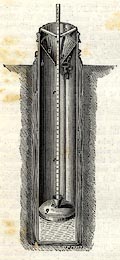




thing to be done was to decide on a gauge which should fulfil the following conditions:- 1, Be easy to read; 2, resist frost; 3, catch some snow; and 4, not be likely to get out of order. Eventually Mr. Casella was instructed to make thirteen gauges, of which the following woodcut has already appeared elsewhere; but the reproduction of which will render the description more intelligible.


The gauge adopted was 4 feet long, and 8 inches in diameter; the can (b) is double, and of very stout zinc; the outer case was wrapped in straw (a), cased in canvass saturated with gas tar, and buried 3 feet deep in the earth, a quantity of tar being poured into the hole as it was filled up, in order, as far as possible, to preserve the canvass, and keep the straw dry. By these measures, and the addition of a little salt to the rain, frost was entirely avoided. The measuring rod (e) is detached, and dropped into the cup (h) when an observation has to be made, the reading being shown by the loose cross-piece (c), which cuts the rod at the true reading, which is shown at 8 1/2 in. The funnel (d) is also moveable, and the inner cylinder being lifted out by the handle (f), the water is readily emptied.
The disposal of these gauges was as follows:- One (No.11 on map p.20) was placed in the garden of Mrs. Dixon's house, at Seathwaite, about 1 foot 6 in. from one of Mr. Fletcher's mountain gauges, and 3 ft. from the old gauge erected by the late Dr. Miller, in 1844. All three are regularly observed, and the records for 1867 will be found on page 42.
No.13 Watendlath is in a garden at the extreme south of the hamlet, free from all buildings, shrubs, &c., about 20 ft. above Watendlath Tarn, and 100 yds. E. of it. The fells rise rather abruptly E. of the gauge.

 British Rainfall 1867, p.16
British Rainfall 1867, p.16